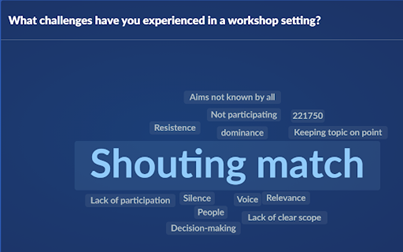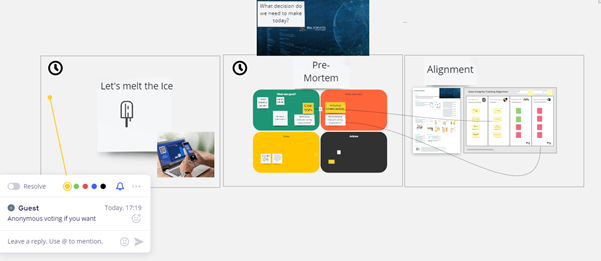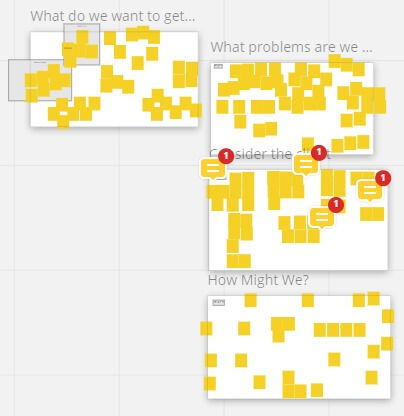What holds up or derails our decision making process?
How many times have we gone into a room with all the stakeholders there, sponsorship for a project already sanctioned and come out 2 hours later somewhat confused, already disengaged or with a feeling of 'my needs won't be met' yet again! and worst of all no decisions made!

Nobody has time for repeat meetings pulling on the same resources and requiring yet more effort because the initial meeting had no activity return outcomes.
Collaboration and Decision Making
If you find that one opinion dominates or only one voice is being heard you may need a facilitator to get your meetings back on track. And using the right meeting solution is also key. How you meet and collaborate has a direct impact on the meeting output and the key decisions to be made.
https://www.gartner.com/reviews/market/meeting-solutions
Maybe it's time to re-engage your stakeholders in a different, more innovative way? Additional challenges of pandemic working have already forced us to look at meeting tools and their effectiveness. Virtual icebreakers are useful and even using the chat function or a meeting poll can help break the ice. If a sense of togetherness is created at project kickoff meetings it will definitely enhance the effectiveness of decision making and overall team engagement.
https://conceptboard.com/blog/icebreakers-in-virtual-teams/
We had a simple but interesting ice Breaker on a recent workshop 'what book or film genre do you prefer'? IT and Validation both preferred Sci Fi but Supply Chain favoured Travel - maybe there's a hidden message here but got loads of laughs.
Also using Slido - Audience Interaction Made Easy as a polling tool is an effective way to get all stakeholders engaged and quickly determine where previous meetings, workshops and issues potentially lay and can be avoided in the future
- essentially you can capture in a quick interactive (and anonymous way if you prefer) a pre-mortem of meeting and decision making challenges which can then be avoided. See the results of a Recent ERA Sciences Workshop poll below. If this poll was performed at the start of a meeting and there was no facilitator available meeting rules could be agreed up front - with a 'no loudest voice agreement' from all stakeholders.

Virtual Meetings vs Face to Face
-
Being virtual is definitely an added challenge to our decision making processes, frustrations can run higher in virtual meetings and where this is not quickly recognised the whole decision making process becomes strained.
-
When real time face to face meetings are not possible it may also require more upfront communication before the virtual meeting takes place- email, plus clear agenda plus explicit outcomes already defined (though really we think these should apply to all meeting types).
-
Projects can be derailed impacting business effectiveness or worse still bad decisions are made because of room biases not being properly managed and this applies to both Virtual and Face to Face settings.
-
Keeping all stakeholders engaged and documenting opinions is key - asking the 'what do you want to get from this project or meeting' is fundamental? this immediately tests the meeting for alignment or points out early on where we are misaligned on goals. We don't all have to have the same view but overall alignment needs to be reached to get decisions made

-
Two hour in person meetings where previously a strain easily become more heated and unproductive when not managed in a virtual setting so planning the time is very important, using ice breakers, polls, virtual parking lots and expecting some level of chaos has to be considered the new norm. Broadband issues and sound challenges need to be considered so consider recording meetings where participants are agreeable and the technology allows.
-
Start to evaluate innovative meeting and workshop solutions to get better, faster, decisions that will result in future pre-mortems of 'project outcomes were achieved' and 'solutions delivered as required'
At ERA Sciences we have been using Design sprint methodology as part of our project planning and implementation workshops to great success - everyone has a voice and there is no loudest voice wins competition.
These Design Sprints allow for more effective brainstorming and look at what the existing business problems are or what they are perceived to be across all involved stakeholders. If everyone is asked to define existing problems on a virtual sticky or white board or even the chat function and given 3 minutes rather than talking over each other for 10 mins it becomes a faster more effective meeting immediately.
Alignment is often there but when it comes to the second part of the meeting sprint - the problem solving or troubleshooting component this is where real alignment usually occurs. Within the meeting stakeholders are put into teams to ideate solutions and bonding and alignment is much more likely to occur. Having cross functional teams is great because it allows an opinion diversity without an opinion animosity and virtual or even 'real' sticky notes and chat functions or fora don't require a volume button to be turned down but the mike gets appropriately shared.

ERA Sciences use planned timed worksessions, everyone gets to put their opinions forward typically as part of a smaller team and a consensus is reached at the end of each session. Yes we do use parking lots but usually they are pretty empty! Having that initial outcome expectation also frames the overall process as no one wants to sit in a room virtual or real without reaching a decision or finalising an outcome.
Maybe it's time to innovate? set meeting rules that can be applied right across the organisation so everyone attends meetings and knows 'what meeting and decision making structure to expect'


Test DRiVE the ERA Meeting Rules toolset

D - Rule 1 - Don't start the meeting without knowing what the objective and desired outcome is and seek alignment - A Decision needs to be made at the end Yes or No?
R - Rule 2 - Have the Right people in the room - this may be primary stakeholders and key team members - a telling tactic is to ask 'do you know why you're here as an ice breaker
i - Rule 3 - Respect the room - No I in Team i - loud voices are gone
V - Rule 4 - Verify AOB and successes/opportunities from previous meeting
E - Rule 5 - Everyone gets a voice and if you use meeting facilitators they listen to these voices and manage the 'heat' if it starts to rise
If you would like more information on stakeholder engagement, decision making and effective meetings management contact us at CONTACT US | ERA Sciences
So what about kickoff meetings ? do they need a decision or defined outcome - Yes

Simple Objective
-
contact details shared
More Detailed Objectives
-
stakeholder involvement clear
-
project timeline agreed
-
any initial issues documented, addressed or parked
There are loads of additional articles out there on how to stop making bad decisions and having clear meeting objectives is a must.
https://conniepodesta.com/15-things-to-quit-today-to-stop-making-bad-decisions/
Let's look at Data Integrity and Application Lifecycle Management Meetings and potential key factors in decision derailment
Lack of a Common Language
ERA Sciences put ' diverse stakeholders' needing common language and understanding as key to getting alignment and overall management of meetings and effective and efficient decision making - so we provide a Glossary of terms , poll our attendees and establish a common terminology and expectation understanding- Take ALCOA+ Available data and records often means different things to different stakeholders
Competing Business Concerns
When it comes to Application Lifecycle Management (ALM) and project planning meetings that involve multiple stakeholders it is often very difficult to ensure all business concerns are captured.
These meetings typically include IT Applications specialists, Business stakeholders, project managers, Quality, Validation and sometimes separate migration teams. A Phased implementation approach is often required to deliver best in class solutions without compromising data integrity or business efficiency.
Delaying Business Inputs due to Resource Constraints
This is a complex group of people with different knowledge, different data integrity concerns so getting the right decisions made at initial kickoff meetings is key to a successful project. At ERA Sciences we have experience in managing these meetings from the get go and front loading business inputs and engagement to ensure the right decisions are reached to provide long term data reliability and integrity.
In you are interested in getting more information on this or any other data reliability and integrity topic please contact us at CONTACT US | ERA Sciences


Comments